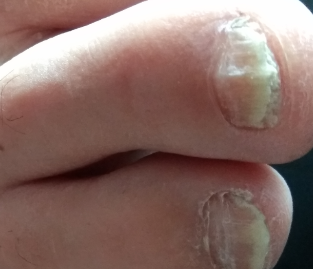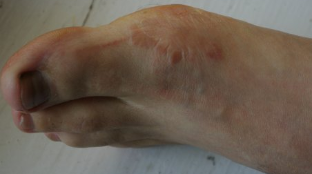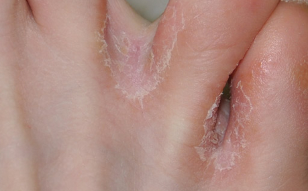If recognize fungal infections of the feet in the initial phase and the time to start the treatment, there is a greater likelihood of a rapid cure using a minimum quantity of anti-fungal medicines, which, in their majority, represent a danger to the health (especially for the liver) for a long period of time of receipt. Unfortunately, not always and not everyone can react in time on the first of the bells to the appearance of fungal defeat, because the symptoms of the initial phase very similar to that harmless of the skin manifestations. A familiar feeling, when discovered a yellow spot on the plate of the toenail and the first thoughts that come to mind – but, by the size of my grow healthy pure ungo or touch something, will soon pass. Or there was a little peeling of skin in interdigital folds, which in 90% attributed to the dryness of the skin and begin to treat moisturizers. And it is for all these "harmless" the most frequent manifestations and hides everyone knows and hate fungus of the feet.
The triggering factors and sources of infection

Pregnancy can lead to the development of fungal diseases, as the woman in this period, it can be observed a strong decrease of the immunity and the violation of the hormonal levels.
Fungal infections of the feet, as many diseases, can not grow itself from its onset and progression need a supportive environment. There are a number of factors and accompanying diseases, causing the onset of this disease:
- the sharp decline in immunity;
- the absence of the violations of personal hygiene;
- increased sweating;
- diabetes mellitus;
- obesity;
- flat feet;
- the disease of the vessels of the lower limbs;
- permanent abrasion and injuries;
- surgical interventions, etc
We have listed the most popular because of the appearance of the fungus of the feet, but even a poor diet or the prolonged use of antibiotics can also cause the development of fungal infections.
The infection occurs most often after using the shoes of the sick person or the visiting public showers. Recent years have recorded a rapid growth in dissemination of fungus through manicure instruments. The sources of infection can be further attributed to:
- products of personal hygiene of the sick person (washcloth, pumice);
- things of an infected person (socks, stockings, shoes, slippers, pants);
- the soil (especially in wood) in the bathroom, the showers, the halls of sport.
The pathogens of the fungal infection of the feet is very resistant to the environment and are distinguished by the fact that he can long remain in a latent state on the wood, towels, socks. The period of exacerbation in spring and autumn.
How to recognize a fungus feet at the initial stage?

Here experienced, the dermatologists recommend to be careful not only external and internal signs. Attention, all walk in baths, swimming pools, sun bathing on the beach, but the fungus infects only the individual? The fact that its development requires an enabling environment – a decrease of the resistance of the organism. Such a condition may be observed in the presence of co-morbidities or recently transferred processing activities, which have been used of antibiotics or hormonal drugs.
Now, we're going to talk about the manifestation of the fungus on the skin of the feet. The main symptoms are:
- the cracks in the interdigital folds;
- the peeling of skin between the fingers;
- a hardening of the skin on the heels;
- down the skin on the soles of the feet, the toes;
- the deformation of the nail plate (thickening or thinning);
- the change of the staining of the nails (yellow, brown, black);
- redness and swelling stop;
- the appearance of red spots on the thighs and to the inside of the legs;
- glitter on the whole surface of the foot;
- pruritus of variable intensity (depends on the location and the pathogen);
- foul odor (most often observed in people suffering from excessive sweating).
When deep fungal infection can observe the appearance of bubbles, crusts and cracks that are accompanied by strong itching and painful sensations. In some cases, the lesions are found in places such as pain not have the ability to become in the leg. This can cause a temporary loss of work capacity and of the problems of displacement.
Varieties and classification
As you already know, yeast infections can be called by different pathogens, on this basis, may modify the localization of lesions of lesions. Most often fungal infections of the feet may be due to:
- dermatomycosis;
- candido mycosis;
- mycosis deep.
All yeast infections stop today are regarded as independent diseases caused by different pathogens and the location on a variety of sites of the feet, but they are united by a single name, and fungi on the feet. The most common are:
- Rubrofitiya stop. Approximately 60% of all fungal infections of the feet. Is distinguished by the high contagiousness, and of the prevalence of certain sectors of the population. The initial phase rubromikoza stop feature defeat between the fingers, folds on the legs. Later in the process involved the insole and the inner side of the foot. The defeat of nail plastic when the rubrofitii observed that every third patient. Quite often combined with the fungus on the hands, especially during the widespread rubromikoze.
- Epidermo mycoses. They include two distinct disease – Epidermofitiya stop and Epidermofitiya folds, inguinal-femoral folds. In both cases, the lesions are localized on the feet. Epidermofitii stop characterized by the defeat of the folds between the toes, the sole and the back of the foot. Less often, the process spreading to the nails (generally, V and I, the toes). The lesions are covered with silvery scales and crust. This pruritus of variable intensity. In severe cases, may experience discomfort and a headache. Inguinal Epidermofitiya manifests itself in the form of large scaly patches in the groin, on the inner side of the legs, the hips and the perianal region. The lesions may reach the size of a large dinner plates, accompanied by mild itching, peeling and swelling.
- The onychomycosis. Each year, the prevalence of fungal infections of the nail is constantly increasing. All the time (according to the statistics of mid-2016) 10 to 18% of russians are diagnosed onychomycosis nail varying degrees of severity. A great importance in their development are environmental and social factors. Also in a risk zone are people who have a problem vascular, immune, and endocrine system. Men suffer from 1.3 times more often than women. In children onychomycosis meet very rarely, the peak prevalence in individuals aged 50 to 70 years.
- Candidiasis. Rarely, but all the same, we noted cases of lesions of the feet fungi (Candida. In rare cases, candidiasis vulvovaginal balanoposthitis can spread to the genitals in the perianal area and the folds inguinal folds. A little more often the yeast-like fungi occur on the nails. At the initial stage of the tenderness of the nail fold of a roller, with a pressure which may be pus. With time, his color wins brown-brown.
There are rubrofitiya a smoother skin, but the lesions are rare on the feet. And here is rubromikozu in the groin feature of the defeat of the inside of my legs red spots.
The treatment and prevention
The diagnosis of mycosis of the feet includes the clinical examination, the decision of scraping of the lesions, the holding of a microscopic examination (see the filaments of mycelium) and the seeding for the definition of the culture of mushrooms. Before the visit to the doctor may not treat lesions of any ways! Differential diagnosis spend with eczema, skin rashes, and contact dermatitis.
The treatment Epidermofitii and rubrofitii in the groin is performed with the help of outside medication (usually Clotrimazole). The prognosis is positive, the treatment period rarely exceeds one month. As prevention, it is recommended for the treatment of lesions alcohol solutions, if the itching can be attributed to antihistamines.

More complex is the situation mycosis stop, and onychomycosis, because even the initial phase are very difficult to treat and prone to relapse. The most effective is thought of as the combination of the outer and the system of drugs, the strict adherence to the dosage, courtesy and rules of disinfection. Well the combination of diflucan in capsules, and of terbinafine in the form of ointment (treatment of lesions 2p/suite in a period of one month. A lot of attention when the fungus feet emphasis on the treatment of shoes and socks that can be the cause of the relapse. Socks, it is advisable to boil or wash at a temperature of 90 degrees, the soles and shoes inside, you need to handle a chlorhexidine solution.
And most of all, remember that, today, of the fungi on the feet, discovered in the initial phase, successfully treatable with modern drugs, and here launched the onychomycosis and mycosis stop can be treated for months and even years.

















